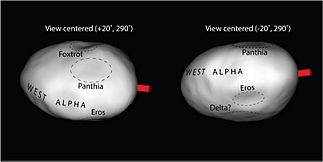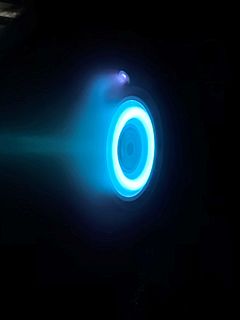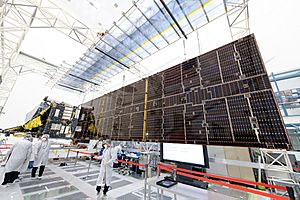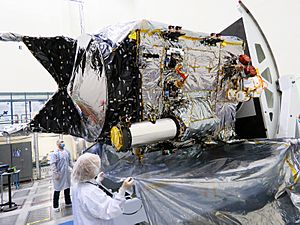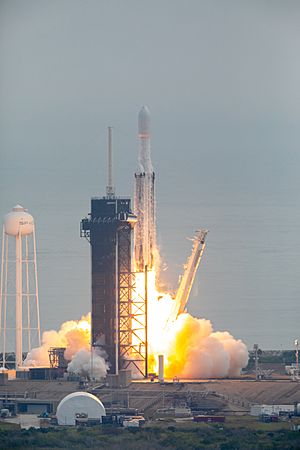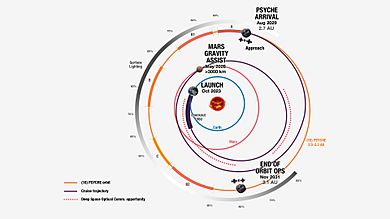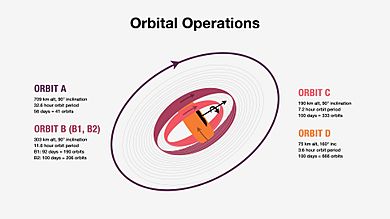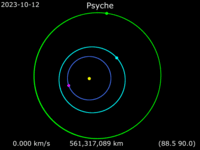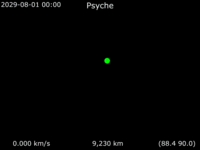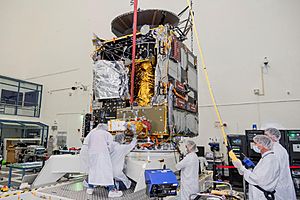Psyche (spacecraft) facts for kids

An illustration of the Psyche spacecraft
|
|
| Mission type | Asteroid orbiter |
|---|---|
| Operator | |
| Website |
|
| Mission duration | Cruise: 5 years, 10 months (planned) Science: 21 months in orbit |
| Spacecraft properties | |
| Spacecraft | Psyche |
| Manufacturer | Maxar Technologies |
| Launch mass | 2,608 kg (5,750 lb) |
| Dry mass | 1,648 kg (3,633 lb) |
| Payload mass | 30 kg (66 lb) |
| Power | 4.5 kW |
| Start of mission | |
| Launch date | October 13, 2023 |
| Rocket | Falcon Heavy |
| Launch site | Kennedy Space Center, LC-39A |
| Contractor | SpaceX |
| 16 Psyche orbiter | |
| Orbital insertion | August 2029 |
 Psyche mission patch |
|
The Psyche mission is a space journey that began on October 13, 2023. Its main goal is to learn how planets get their metal centers, or cores. It will do this by orbiting and studying a special asteroid called 16 Psyche.
Lindy Elkins-Tanton from Arizona State University is the main scientist who suggested this mission. It is part of NASA's Discovery Program. NASA's Jet Propulsion Laboratory (JPL) is in charge of running the project.
The asteroid 16 Psyche is the heaviest known M-type asteroid. M-type means it is mostly made of metal. Scientists once thought it was the exposed iron core of a young planet that lost its outer layers in a huge crash. However, newer studies suggest this might not be true. Radar observations from Earth show it is likely made of iron and nickel. The Psyche mission was chosen by NASA on January 4, 2017. It was launched into space by a SpaceX Falcon Heavy rocket.
Contents
Mission History
The idea for the Psyche mission was first suggested to NASA in February 2015. It was one of five ideas chosen in September 2015. Each team received US$3 million to develop their plans further.
On January 4, 2017, Psyche was officially chosen as the 14th Discovery mission. It was planned to launch in 2023. Later, in May 2017, the launch date was moved up to July 2022. This earlier date would allow the spacecraft to take a faster path to the asteroid. It would arrive on January 31, 2026, after getting a boost from Mars's gravity in May 2023.
In June 2022, NASA announced a delay. The equipment and software for the spacecraft were delivered late. This meant there wasn't enough time to finish all the necessary tests. New launch times were set for 2023 or 2024. These would lead to the spacecraft reaching the asteroid in 2029 or 2030.
On October 28, 2022, NASA said the mission was aiming for a launch between October 10 and October 25, 2023. This would allow it to arrive at the asteroid in August 2029.
The launch date changed a few more times. On April 18, 2023, it was updated to October 5, 2023. Then, on September 28, 2023, it was delayed to October 12 due to a problem with the spacecraft. Finally, bad weather pushed the launch to October 13, 2023.
An independent review in November 2022 looked into the delays at JPL. It found problems like not enough staff, poor planning, and communication issues. Another mission, called VERITAS, was delayed to allow staff to focus on Psyche.
About the Mission
The Psyche spacecraft uses solar electric propulsion. This means it uses electricity from solar panels to power its engines. It carries several science tools. These include a camera that takes images in different colors, a tool to measure magnetic fields, and a tool to detect gamma-rays.
The mission is planned to collect science data for 21 months. The spacecraft was built by NASA's Jet Propulsion Laboratory (JPL). They worked with SSL (a company that builds satellites) and Arizona State University.
At first, there was a plan to share the rocket launch with another mission called Athena. This mission would have flown past asteroid 2 Pallas. Later, in May 2020, it was announced that the Falcon Heavy rocket would carry two smaller satellites. These were called EscaPADE and Janus. They were meant to study Mars's atmosphere and binary asteroids. However, EscaPADE was removed in September 2020. Janus was also removed in November 2022. This was because Psyche's new launch time meant Janus would not be on the right path for its own science goals.
Mission Goals and Objectives
Understanding how planets separate into layers (like a core, mantle, and crust) is very important. Directly studying a metal core like Psyche could help us understand this process better. The Psyche mission aims to learn about the asteroid's geology, shape, and what it's made of. It will also study its magnetic field and how its mass is spread out. This mission is expected to help us understand how planets form and what their insides are like.
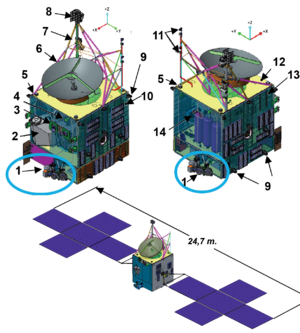
1. Hall-effect thrusters
2. Optical telecommunications system
3. Star trackers
4. Low-gain antenna
5. Sun sensor
6. X-band High-gain antenna
7. Neutron spectrometer
8. Gamma-ray spectrometer
9. Cold gas thrusters
10. -Y Panel
11. Magnetometer
12. Top deck
13. +Y Panel
14. Multispectral imagers (x2)
Here are the main science goals for the mission:
- To understand a part of planet formation that we haven't explored before: iron cores.
- To look inside rocky planets, including Earth. We can do this by directly studying the inside of a body that has separated into layers, which we normally can't see.
- To explore a new type of world, one made mostly of metal.
The specific science objectives are:
- To find out if 16 Psyche is truly a core, or if it's made of material that never melted.
- To figure out the ages of different areas on 16 Psyche's surface.
- To see if small metal bodies have the same light elements that we expect to find in Earth's core.
- To learn if 16 Psyche formed in conditions that were more oxidizing or reducing than Earth's core.
- To map 16 Psyche's surface features and height differences.
The mission also wants to answer these questions:
- Is 16 Psyche the stripped core of a small planet, or did it form as a body rich in iron? What were the building blocks of planets? Did small planets that formed close to the Sun have very different materials?
- If 16 Psyche lost its outer layers, when and how did that happen?
- If 16 Psyche was once molten, did it cool from the inside out, or the outside in?
- Did 16 Psyche create a magnetic field as it cooled?
- What are the main metal mixtures found in the iron core?
- What are the key features of its surface and overall shape? Does 16 Psyche look very different from known rocky or icy bodies?
- How do craters on a metal body compare to those on rock or ice?
Science Tools
The Psyche spacecraft carries about 30 kg (66 lb) of science tools. There are four main instruments:
- The multispectral imager takes detailed pictures. It uses filters to tell the difference between metal and rocky materials.
- The gamma ray and neutron spectrometer will study and map what elements the asteroid is made of.
- The magnetometer will measure and map any leftover magnetic field the asteroid has.
- The X-band Gravity Science Investigation uses the X-band radio system. This system helps scientists measure the asteroid's gravity field. From this, they can figure out what its inside structure is like.
The Spacecraft
The main part of the spacecraft is built on the Space Systems Loral (SSL) 1300 platform. JPL added the systems for handling commands and data, and for communication. They also added all the flight software.
How it Moves (Propulsion)
| SPT-140 | What it is / Units |
|---|---|
| Type | Hall-effect thruster |
| Power | Max: 4.5 kW Min: 900 watts |
| Specific impulse (Isp) | 1800 seconds |
| Thrust | 280 mN |
| Thruster mass | 8.5 kg |
| Propellant mass | 922 kg of xenon |
| Total impulse | 8.2 MN·s (for Psyche) |
The spacecraft uses four SPT-140 engines. These are Hall-effect thrusters that use solar electric propulsion. This means they get electricity from solar panels to power an electric rocket engine, not a chemical one. The thruster can work at 4.5 kW of power, but it can also run for long times at about 900 watts. Psyche is the first mission to use Hall-effect thrusters beyond the Moon's orbit.
The SPT-140 thruster was first developed in the USSR. It has been improved by NASA and other companies since the late 1980s.
Using these solar electric thrusters helps the spacecraft reach 16 Psyche much faster. It also uses less than 10% of the fuel that a regular chemical rocket would need.
Power Source
| Solar panels | What they are / Units |
|---|---|
| Type | Triple-Junction Solar Cells |
| Power | Solar array performance: At Earth: 20 kW At 16 Psyche: 2.3 kW |
Electricity for the spacecraft comes from two large solar panels. They are arranged in an X-shape, with five panels on each side. Originally, the panels were planned to be in straight lines, with four panels on each side.
Laser Communication Experiment
The spacecraft will also test a new laser communication technology. It is called Deep Space Optical Communications (DSOC). Scientists hope this device will make sending data from spacecraft 10 to 100 times faster and more efficient. DSOC is NASA's first test of optical communication beyond the Earth-Moon system.
The DSOC system has a laser device on the spacecraft, a laser transmitter on Earth, and a laser receiver on Earth. New technologies have been used in each part. The laser device is on the Psyche spacecraft. The DSOC test will start soon after launch. It will continue as the spacecraft travels from Earth to Mars for its gravity assist. DSOC operations are planned for one year after launch. The Palomar Observatory's Hale Telescope will receive the fast data sent by the DSOC device.
The Discovery program offered missions an extra $30 million if they would carry and test the DSOC unit. The DSOC unit weighs 25 kg and needs about 75 watts of power. The goal is to make DSOC technology ready for future missions. Tests of the laser equipment will happen over distances from 0.1 to 2.5 astronomical units (AU) as the probe travels away from Earth.
The DSOC laser device on the spacecraft has a special laser that sends data using near-infrared light. It also has a sensitive camera to receive a laser beam from Earth. The device's telescope is 8.6 inches (22 centimeters) wide. It is mounted on a system that keeps it steady from spacecraft vibrations. The hardware has a sunshade and sticks out from the side of the spacecraft. This makes it easy to spot on Psyche.
On Earth, a powerful near-infrared laser transmitter at JPL's Table Mountain facility will send a laser beam to the spacecraft. This beam will also act as a guide for the spacecraft's laser device to lock onto. The data sent back by the DSOC device on Psyche will be collected by the 200-inch (5.1-meter) Hale Telescope at Palomar Observatory. This telescope uses a very sensitive receiver to show how fast data can be sent.
Mission Operations
Launch and Journey
Psyche's launch period started on October 5, 2023. There were daily launch times until October 25. On September 28, NASA announced a one-week delay due to issues with the spacecraft's thrusters. This moved the launch from October 5 to October 12. Bad weather then caused another delay to October 13.
Psyche successfully launched on October 13, 2023, at 10:19 am EDT. It lifted off on a Falcon Heavy rocket from Launch Pad 39A at Kennedy Space Center. This was the eighth Falcon Heavy launch and the first one for NASA. The two side boosters of the rocket had flown four times before. They landed back at Cape Canaveral a few minutes after liftoff and will be used again. The main core stage of the rocket was not recovered.
The Psyche spacecraft separated from the rocket's upper stage 62 minutes after launch. Ground controllers quickly received a signal from the spacecraft. This signal gave them information about its status before the solar panels opened. Full communication with the spacecraft was set up at 11:50 am EDT. The spacecraft then began a 100-day period to test and set up all its systems and tools.
The cost of the launch was US$117 million. Psyche will use a gravity assist maneuver at Mars in 2026. This will help guide the spacecraft to arrive at the asteroid in August 2029.
Orbiting the Asteroid
The spacecraft will begin its approach to 16 Psyche in May 2029. It will start taking navigation images and measurements of the asteroid. At this point, the asteroid will still look like just a few pixels. The spacecraft will then use its electric propulsion system to get caught by the asteroid's gravity. This is expected to happen in late July 2029. When this happens, the first close-up images of 16 Psyche will be taken. The asteroid will appear about 500 pixels wide. Over the next 20 days, the spacecraft will move into the first of four science orbits.
Psyche is set to start orbiting 16 Psyche in August 2029. The spacecraft will orbit the asteroid at four different heights. These are named alphabetically from highest (A) to lowest (D). In the original plan, the spacecraft would go from the highest orbit to the lowest. But after the 2022 launch delay, the plan changed. The spacecraft will now arrive at a different point in the asteroid's orbit around the Sun.
In the new plan, Psyche will first enter Orbit A. Then it will go down to Orbit B1, then Orbit D. After that, it will go back up to Orbit C, and finally to Orbit B2. This new path makes sure that the asteroid's surface is lit up by the Sun correctly during Orbit B.
Its first orbit, Orbit A, will be 700 km (430 mi) high. It will stay here for 56 days to map the magnetic field and make initial maps. Then it will go down to Orbit B, at 303 km (188 mi) altitude, for 92 days. Here it will study the asteroid's shape and magnetic field. Next, it will descend to Orbit D, the lowest orbit at 75 km (47 mi). This orbit is special because it goes around the asteroid's equator. It will stay here for 100 days to find out what elements are on the surface using its gamma-ray and neutron spectrometers.
After that, it will go up to Orbit C at 190 km (120 mi) altitude for 100 days. Here it will study gravity and continue magnetic field observations. Finally, the orbiter will return to Orbit B for another 100 days. This is to finish mapping the part of the asteroid that was in darkness during the first Orbit B. It will also continue taking images and mapping gravity and magnetic fields. In total, the main mission is expected to last 26 months, ending in November 2031. At the end of the mission, the spacecraft will be left orbiting the asteroid.
| Orbit regime | Date (UTC) |
Duration (day) |
Orbital period (hour) |
Altitude (km) |
Inclination (degree) |
Transfer to
next orbit |
Mission |
|---|---|---|---|---|---|---|---|
| Orbit A | August 2029 | 56 | 32.8 | 700 | 90 | 17 | Magnetic field characterization and preliminary mapping |
| Orbit B1 | October 2029 | 92 | 11.6 | 303 | 90 | 98 | Topography and magnetic field characterization |
| Orbit D | May 2030 | 100 | 3.6 | 75 | 160 | Determining the chemical composition of the surface | |
| Orbit C | January 2031 | 100 | 7.2 | 190 | 90 | Gravity investigations and Magnetic field observations | |
| Orbit B2 | May 2031 | 100 | 11.6 | 303 | 90 | Topography and magnetic field characterization |
Ground Stations for Laser Link
The laser beams from the spacecraft will be received by a large telescope at Palomar Observatory in California. Laser beams sent to the spacecraft will come from a smaller telescope at JPL Table Mountain Facility.
Building and Testing the Spacecraft
Testing the Spacecraft
Testing of the spacecraft began in December 2021. These tests included checking its electronics and magnetic parts. This was to make sure they wouldn't interfere with each other during the mission. They also did "TVAC" (thermal vacuum chamber) testing. This test happens inside a huge vacuum chamber at JPL's facility in Southern California. The chamber creates conditions like space, with no air. This lets engineers see how the spacecraft reacts to the harsh environment.
Inside the TVAC, JPL employees can see how well the spacecraft handles extreme heat and cold. Without air, the spacecraft heats up a lot when it's close to Earth and facing the Sun. Later, when it's far from the Sun, it faces intense cold, especially when flying in Psyche's shadow.
Scientists and engineers also did vibration tests. This ensures the spacecraft can survive the shaking of the rocket launch. They performed shock testing to make sure the spacecraft could handle the jolt of separating from the rocket. Finally, they did acoustic testing. The sound of a launch can be so loud it can damage hardware. So, intense sound tests were done to ensure the mission would succeed.
See also
 In Spanish: Psyche (nave espacial) para niños
In Spanish: Psyche (nave espacial) para niños



